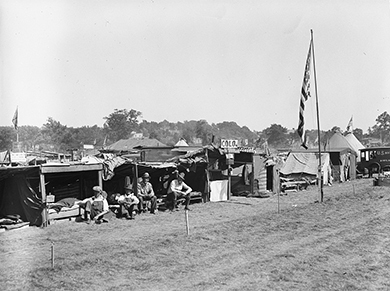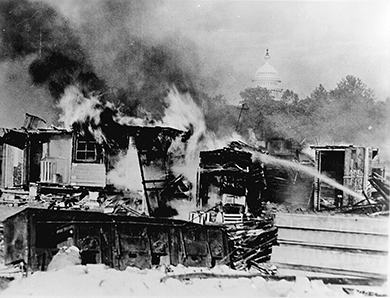| << Chapter < Page | Chapter >> Page > |
One of the most notable protest movements occurred toward the end of Hoover’s presidency and centered on the Bonus Expeditionary Force, or Bonus Army , in the spring of 1932. In this protest, approximately fifteen thousand World War I veterans marched on Washington to demand early payment of their veteran bonuses, which were not due to be paid until 1945. The group camped out in vacant federal buildings and set up camps in Anacostia Flats near the Capitol building ( [link] ).

Many veterans remained in the city in protest for nearly two months, although the U.S. Senate officially rejected their request in July. By the middle of that month, Hoover wanted them gone. He ordered the police to empty the buildings and clear out the camps, and in the exchange that followed, police fired into the crowd, killing two veterans. Fearing an armed uprising, Hoover then ordered General Douglas MacArthur, along with his aides, Dwight Eisenhower and George Patton, to forcibly remove the veterans from Anacostia Flats. The ensuing raid proved catastrophic, as the military burned down the shantytown and injured dozens of people, including a twelve-week-old infant who was killed when accidentally struck by a tear gas canister ( [link] ).

As Americans bore witness to photographs and newsreels of the U.S. Army forcibly removing veterans, Hoover’s popularity plummeted even further. By the summer of 1932, he was largely a defeated man. His pessimism and failure mirrored that of the nation’s citizens. America was a country in desperate need: in need of a charismatic leader to restore public confidence as well as provide concrete solutions to pull the economy out of the Great Depression.
Whether he truly believed it or simply thought the American people wanted to hear it, Hoover continued to state publicly that the country was getting back on track. Listen as he speaks about the “Success of Recovery” at a campaign stop in Detroit, Michigan on October 22, 1932.
President Hoover’s deeply held philosophy of American individualism, which he maintained despite extraordinary economic circumstances, made him particularly unsuited to deal with the crisis of the Great Depression. He greatly resisted government intervention, considering it a path to the downfall of American greatness. His initial response of asking Americans to find their own paths to recovery and seeking voluntary business measures to stimulate the economy could not stem the tide of the Depression. Ultimately, Hoover did create some federal relief programs, such as the Reconstruction Finance Corporation (RFC), which sought to boost public confidence in financial institutions by ensuring that they were on solid footing. When this measure did little to help impoverished individuals, he signed the Emergency Relief Act, which allowed the RFC to invest in local public works projects. But even this was too little, too late. The severe limits on the types of projects funded and type of workers used meant that most Americans saw no benefit.
The American public ultimately responded with anger and protest to Hoover’s apparent inability to create solutions. Protests ranged from factory strikes to farm riots, culminating in the notorious Bonus Army protest in the spring of 1932. Veterans from World War I lobbied to receive their bonuses immediately, rather than waiting until 1945. The government denied them, and in the ensuing chaos, Hoover called in the military to disrupt the protest. The violence of this act was the final blow for Hoover, whose popularity was already at an all-time low.

Notification Switch
Would you like to follow the 'U.s. history' conversation and receive update notifications?